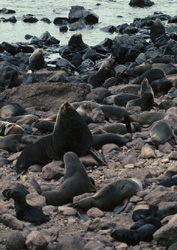Guadalupe Fur Seal
(Arctocephalus townsendi)
IUCN STATUS (2010) - NEAR THREATENED
| Distribution and Numbers The rarest fur seal, and only species of Arctocephalus found north of the equator, the Guadalupe fur seal breeds on Isla de Guadalupe and Isla Benito del Este off the coast of Baja California, Mexico. Individuals are also occasionally sighted as far south as Tapachula near the Mexico / Guatemala border, as far north as the Point Reyes National Seashore in California, and in the Gulf of California. There are estimated to be about 7,000 Guadalupe fur seals, the population increasing as it recovers from heavy exploitation. |
 Photo: Phillip Colla, Phillip Colla Wildlife Photography |
| Status Guadalupe fur seals were nearly wiped out by intensive commercial sealing in the late 1700s and early 1800s. They disappeared from southern Californian waters by 1825 and continued to be hunted commercially in Mexican waters until 1894. Their pre-exploitation range may have extended from the Mexican Revillagigedo Islands north to Monterey Bay in California, and they may have had breeding colonies on the Californian San Miguel and San Nicolas Islands. It is thought that there could have been 20,000 - 100,000 Guadalupe fur seals prior to their commercial exploitation. |
 Photo: Phillip Colla, Phillip Colla Wildlife Photography |
The species was considered extinct after most of the population was killed in 1928 but it was rediscovered in 1954. The Guadalupe fur seal is now fully protected by Mexican national legislation, the Isla de Guadalupe having been declared a pinniped sanctuary in 1975. It is protected in the U.S. portion of its range by Californian law, as a Threatened species under the U.S. Endangered Species Act, and as a Depleted and Strategic species under the U.S. Marine Mammal Protection Act. The species is also listed as Near Treatened on the IUCN Red List and as an Appendix I species under CITES. Some Guadalupe fur seals may be killed by entanglement in drift and set gillnets but there is insufficient data on this problem. Individuals, especially juvenile females, have also been found stranded with injuries caused by entanglement in marine debris. There was a 33% pup mortality in 1992 due to El Nino and Hurricane "Darby" but it is not yet known how the population was affected by the 1997-1998 El Nino event. |
| Lifestyle The Guadalupe fur seal is one of the least-studied of all the fur seal species, due partly to its geographical isolation. However it is known that Guadalupe fur seals breed at rocky sites or in caves on the eastern coast of Isla de Guadalupe, adult males fighting to form territories where there will be an average of 4, but up to 12, females. The females start arriving at the breeding sites in June and give birth to a pup within a few days of their arrival. Pups are born from early June to early August with a black coat, similar to the adult coat which is dark brown to black with light tan hairs on the back of the neck. About 7-8 days after the birth of her pup the mother mates and then leaves to feed at sea. This begins a cycle, lasting about 8-9 months, where she will spend an average of 9-13 days at sea before returning to land to nurse her pup for an average of 5-6 days. These feeding and nursing durations are long compared to other eared seals. |
| Guadalupe fur seals do not migrate. They are known to feed on squid and fish such as myctophids and mackerel. Research on a group of adult females showed them to be feeding in the California Current south of Isla de Guadalupe, making round trips of 704 - 4,092km (average 2,375km). One of the females was found to be diving, almost entirely at night, to an average depth of 17m for an average duration of about 2.5 minutes. Sharks are known to prey on Guadalupe fur seals. Statistics The average adult male measures 2.2m in length and weighs 188kg, while the average adult female is smaller at 1.5m in length and 49kg in weight. It is not known how long Guadalupe fur seals can live, but it is thought that males may live over 13 years while females may live up to 23 years. |
 Photo: Phillip Colla, Phillip Colla Wildlife Photography |
